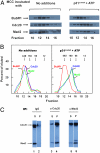p31comet Promotes disassembly of the mitotic checkpoint complex in an ATP-dependent process
- PMID: 21300909
- PMCID: PMC3044357
- DOI: 10.1073/pnas.1100023108
p31comet Promotes disassembly of the mitotic checkpoint complex in an ATP-dependent process
Abstract
Accurate segregation of chromosomes in mitosis is ensured by a surveillance mechanism called the mitotic (or spindle assembly) checkpoint. It prevents sister chromatid separation until all chromosomes are correctly attached to the mitotic spindle through their kinetochores. The checkpoint acts by inhibiting the anaphase-promoting complex/cyclosome (APC/C), a ubiquitin ligase that targets for degradation securin, an inhibitor of anaphase initiation. The activity of APC/C is inhibited by a mitotic checkpoint complex (MCC), composed of the APC/C activator Cdc20 bound to the checkpoint proteins MAD2, BubR1, and Bub3. When all kinetochores acquire bipolar attachment the checkpoint is inactivated, but the mechanisms of checkpoint inactivation are not understood. We have previously observed that hydrolyzable ATP is required for exit from checkpoint-arrested state. In this investigation we examined the possibility that ATP hydrolysis in exit from checkpoint is linked to the action of the Mad2-binding protein p31(comet) in this process. It is known that p31(comet) prevents the formation of a Mad2 dimer that it thought to be important for turning on the mitotic checkpoint. This explains how p31(comet) blocks the activation of the checkpoint but not how it promotes its inactivation. Using extracts from checkpoint-arrested cells and MCC isolated from such extracts, we now show that p31(comet) causes the disassembly of MCC and that this process requires β,γ-hydrolyzable ATP. Although p31(comet) binds to Mad2, it promotes the dissociation of Cdc20 from BubR1 in MCC.
Conflict of interest statement
The authors declare no conflict of interest.
Figures



Similar articles
-
Role of phosphorylation of Cdc20 in p31(comet)-stimulated disassembly of the mitotic checkpoint complex.Proc Natl Acad Sci U S A. 2012 May 22;109(21):8056-60. doi: 10.1073/pnas.1204081109. Epub 2012 May 7. Proc Natl Acad Sci U S A. 2012. PMID: 22566641 Free PMC article.
-
Mode of interaction of TRIP13 AAA-ATPase with the Mad2-binding protein p31comet and with mitotic checkpoint complexes.Proc Natl Acad Sci U S A. 2015 Sep 15;112(37):11536-40. doi: 10.1073/pnas.1515358112. Epub 2015 Aug 31. Proc Natl Acad Sci U S A. 2015. PMID: 26324890 Free PMC article.
-
Disassembly of mitotic checkpoint complexes by the joint action of the AAA-ATPase TRIP13 and p31(comet).Proc Natl Acad Sci U S A. 2014 Aug 19;111(33):12019-24. doi: 10.1073/pnas.1412901111. Epub 2014 Aug 4. Proc Natl Acad Sci U S A. 2014. PMID: 25092294 Free PMC article.
-
The mitotic checkpoint: a signaling pathway that allows a single unattached kinetochore to inhibit mitotic exit.Prog Cell Cycle Res. 2003;5:431-9. Prog Cell Cycle Res. 2003. PMID: 14593737 Review.
-
Dual inhibition of Cdc20 by the spindle checkpoint.J Biomed Sci. 2007 Jul;14(4):475-9. doi: 10.1007/s11373-007-9157-3. Epub 2007 Mar 17. J Biomed Sci. 2007. PMID: 17370142 Review.
Cited by
-
Conformation-specific anti-Mad2 monoclonal antibodies for the dissection of checkpoint signaling.MAbs. 2016 May-Jun;8(4):689-97. doi: 10.1080/19420862.2016.1160988. Epub 2016 Mar 17. MAbs. 2016. PMID: 26986935 Free PMC article.
-
Emerging regulatory mechanisms in ubiquitin-dependent cell cycle control.J Cell Sci. 2012 Jan 15;125(Pt 2):255-63. doi: 10.1242/jcs.091199. J Cell Sci. 2012. PMID: 22357967 Free PMC article. Review.
-
Using default constraints of the spindle assembly checkpoint to estimate the associated chemical rates.BMC Biophys. 2012 Jan 19;5:1. doi: 10.1186/2046-1682-5-1. BMC Biophys. 2012. PMID: 22260411 Free PMC article.
-
p31(comet) acts to ensure timely spindle checkpoint silencing subsequent to kinetochore attachment.Mol Biol Cell. 2011 Nov;22(22):4236-46. doi: 10.1091/mbc.E11-03-0216. Epub 2011 Sep 30. Mol Biol Cell. 2011. PMID: 21965286 Free PMC article.
-
Mad2 Overexpression Uncovers a Critical Role for TRIP13 in Mitotic Exit.Cell Rep. 2017 May 30;19(9):1832-1845. doi: 10.1016/j.celrep.2017.05.021. Cell Rep. 2017. PMID: 28564602 Free PMC article.
References
-
- Bharadwaj R, Yu H. The spindle checkpoint, aneuploidy and cancer. Oncogene. 2004;23:2016–2027. - PubMed
-
- Kops GJ, Weaver BA, Cleveland DW. On the road to cancer: Aneuploidy and the mitotic checkpoint. Nat Rev Cancer. 2005;5:773–785. - PubMed
-
- Musacchio A, Salmon ED. The spindle checkpoint in space and time. Nat Rev Mol Cell Bio. 2007;8:379–393. - PubMed
-
- Peters JM. The anaphase-promoting complex/cyclosome: A machine designed to destroy. Nat Rev Mol Cell Bio. 2006;7:644–656. - PubMed
-
- Van Leuken R, Clijters L, Wolthuis R. To cell cycle, swing the APC/C. Biochim Biophys Acta. 2008;1786:49–59. - PubMed
Publication types
MeSH terms
Substances
LinkOut - more resources
Full Text Sources
Molecular Biology Databases
Miscellaneous

